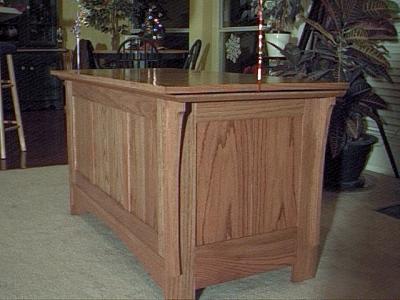|
Various comments on finishing Oak to fill the Pores... Jon Riggs, 02-16-2004 02:19 PM Do any of the big box stores sell pore filler for oak? I can't find anything in my little home town and I've wanted to try it so I can get a smooth finish on an oak surface. I swear you can never fill up the pores in red oak with varnish. It keeps drinking it in and leaving a low spot. Can someone recommend an easily obtainable brand that they use and like. Thanks to all and have a great Monday. Jon Tampa Tom, 02-16-2004 02:24 PM Here's something from Rockler which looks promising... This link. vicia, 02-16-2004 02:45 PM About all Duane works with is red oak, and uses Minwax sealer, then poly varnish 2-3 coats, sanding inbetween. He doesn't always use the sealer, but he sands more than is "normal". He has not had much problem with low spots. Vicki and Duane Olepeddler, 02-16-2004 03:19 PM Some of the others may chime in here but I suspect you're going to hear about shelac. The blond flake cut pretty thin make an excellant sealer and fill pretty well. I've used it on oak ply and it does a pretty good job of filling. Joe T lomax, 02-16-2004 11:41 PM I have used Moser's waterbased filler from Woodworker's Supply of Wyoming and it has worked quite well. Apply with a plastic scraper. Let it dry, and sand it off. A second coat may be necessary but not usually. I think it is available from a number of other sources but they are all mail order to me. Lomax one-man-shop, 02-17-2004 01:27 AM I recently built an oak hope chest, and the instructions I followed included the steps for a "slurry" finish. Basically, one part poly, one part tung oil, one part alcohol and one part stain if you are using any. Apply libberaly to a small area and sand with some 400 grit wet dry paper. The idea being to get enough fine sawdust mixed in to the finish to create the "slurry". Worked for me. The chest is sitting in the dining room, and months after building it, I still run my hand over the glass smooth top whenever I walk by, and think "Man! did I do that! ". I settled with a few coats of varnish and OOOO steel wool on most surfaces, and slaved on the top only. Too labor intensive. Allen NorthernBird, 02-17-2004 10:07 AM The october or november issue of Wood magazine (the one with the dinning table on the cover) had an article on both the filler and slurry methods of creating a silk smooth finish on oak. Check it out. vicia, 02-17-2004 11:40 AM You can also use sealer and rottenstone, if you want to take the time. But, like I said, Duane usually just uses poly, and it seems to work out fine. Vicki and Duane Joe Lyddon, 02-17-2004 01:38 PM Originally posted by one-man-shop: "slurry" finish. Allen Allen, Do you think this work OK for Oak plywood? Sounds like a nice way to do it! I suppose you could use the same on Ash, Mahogany, or any other wood with heavy pores? Have fun! Joe one-man-shop, 02-17-2004 11:03 PM Actually Joe, That lid is 3/4 red oak plywood with a 2" red oak frame on three sides. Worked for me. Of course I built it for my daughter and didn't mind the work. I think you can catch the shine in this shot.  JigSaw Mama, 02-18-2004 02:51 AM Vicki, What is "rottenstone"? Thanks. Trisha MarcSpag, 02-18-2004 02:04 PM I would recommend against using poly alone to fill pores. Mind you, my projects arent really old enough to test the theory, but I have read several articles that explain it. Apparently poly has a tendency to settle/compress/shrink over time. Regardless of the thickness, the poly will shrink by the same percentage in the grain and on the non-grain sections. Therefore, the poly in the pores will eventually reveal the pores once again. It may take months or even years, depending on how thick the poly was built up, but it will happen eventually. (In theory, of course) vicia, 02-18-2004 03:22 PM Trisha, Rottenstone, when used with sealer and poly, makes the tables etc. "smooth as a baby's bottom" If anyone is interested in the special formula or way that the Amana Colonies in eastern Iowa do their finishes, they gave Duane a copy when we were there, they are several steps, but makes for a beautiful table top. You can see the shiny finish on the inlay tables in our pics (along with my flash!) Vicki   This site is maintained by: Good-Lyddon Data Systems Copyright © 2004-2010 Joe Lyddon, WoodWorkStuff.net |